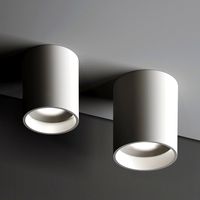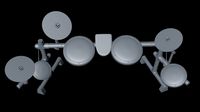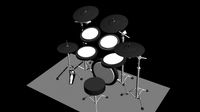GrabCAD

Chevron Drum
by GrabCAD
Last crawled date: 1 year, 11 months ago
My Drum design extends to the full allowable dimensions, 450 mm diameter and 360 mm
width. A 1:4 model (tested with builders sand) has consistently filled to 58%, whilst a full
size drum could take that to >60%.
The chevron ‘tread’ and slight taper of the drum, directs loose material to the edges of the
drum, where (6) scoops each end (alternately) ingest an amount of the material, filling the
scoop cavity.
As the drum rotates, the scoop cavity contents are lifted, where the additional weight of the
contents open an inner flap, allowing the material to fall into the drum interior from a high
position in the drum. Drum contents (lower down) keep other flaps closed/sealed and
prevent contents falling out. As the drum fills, it reaches a point where the flaps are
prevented from opening (its maximum fill). This point is determined by the rill angle of the
material, and/or its tendency to clump/stick together. This point can be extended by
vibration of the drum, or a pulsed drive.
To empty the contents, the home-base processing facility will require an ‘unloading station’ the device drives into (not just a hole in the ground) containing a mechanism to push at the end of the
drums. When the drum end is pressed and released, the drum splits apart at the middle, allowing the contents to quickly spill out (assisted by the taper). When empty, press again to bring the two drum halves back together and lock closed.
The mobile device’ prime function is to travel to site, load material and return to home-base.
The unloading station should handle its function. Preferable to incorporate a method
for unloading into the stationery home-base facility than add complexity/weight to the
mobile device.
The drum to be constructed of Titanium by 3D printing a combined scoop end and inner
drum half (as one), with the other half being a mirror of that. The flaps would be of a
flexible elastomer (silicone or similar) with variable thickness (stiffness), located/fitted over
the inner end of each scoop cavity.
With Titanium density of 4.6 gr/cm³ the overall weight would be 4.78 kg. To reduce wear, it
could be coated with diamond via chemical vapor deposition (CVD), which would put it
above the 5.0 kg limit. If reducing wear is a high priority, drum width could be reduced to
suit and possibly still provide the minimum 17.5 Lt capacity.
The STL provided of the drum was just scaled up from that used to 3D print the plastic
model, so does not represent the actual wall thicknesses (mostly 0.8-1.0 mm) if printed at
full-size in Titanium. Nor does it show the flap configuration, or open/close mechanism.
Though not part of the competition, I have several other ideas related to the overall
RASSOR device, relating to seals, wheels and overall length.
width. A 1:4 model (tested with builders sand) has consistently filled to 58%, whilst a full
size drum could take that to >60%.
The chevron ‘tread’ and slight taper of the drum, directs loose material to the edges of the
drum, where (6) scoops each end (alternately) ingest an amount of the material, filling the
scoop cavity.
As the drum rotates, the scoop cavity contents are lifted, where the additional weight of the
contents open an inner flap, allowing the material to fall into the drum interior from a high
position in the drum. Drum contents (lower down) keep other flaps closed/sealed and
prevent contents falling out. As the drum fills, it reaches a point where the flaps are
prevented from opening (its maximum fill). This point is determined by the rill angle of the
material, and/or its tendency to clump/stick together. This point can be extended by
vibration of the drum, or a pulsed drive.
To empty the contents, the home-base processing facility will require an ‘unloading station’ the device drives into (not just a hole in the ground) containing a mechanism to push at the end of the
drums. When the drum end is pressed and released, the drum splits apart at the middle, allowing the contents to quickly spill out (assisted by the taper). When empty, press again to bring the two drum halves back together and lock closed.
The mobile device’ prime function is to travel to site, load material and return to home-base.
The unloading station should handle its function. Preferable to incorporate a method
for unloading into the stationery home-base facility than add complexity/weight to the
mobile device.
The drum to be constructed of Titanium by 3D printing a combined scoop end and inner
drum half (as one), with the other half being a mirror of that. The flaps would be of a
flexible elastomer (silicone or similar) with variable thickness (stiffness), located/fitted over
the inner end of each scoop cavity.
With Titanium density of 4.6 gr/cm³ the overall weight would be 4.78 kg. To reduce wear, it
could be coated with diamond via chemical vapor deposition (CVD), which would put it
above the 5.0 kg limit. If reducing wear is a high priority, drum width could be reduced to
suit and possibly still provide the minimum 17.5 Lt capacity.
The STL provided of the drum was just scaled up from that used to 3D print the plastic
model, so does not represent the actual wall thicknesses (mostly 0.8-1.0 mm) if printed at
full-size in Titanium. Nor does it show the flap configuration, or open/close mechanism.
Though not part of the competition, I have several other ideas related to the overall
RASSOR device, relating to seals, wheels and overall length.
Similar models
grabcad
free

Side Winder Excavation Drum
...vertical excavation forces and instead combines with axial forces similar to those a screw would exert to excavate, leading...
grabcad
free

NASA Bucket Drum Challenge
... of around 27 liters. this design is expected to have a fill ratio exceeding 50%, as well as obtain over 17.6 liters of material.
grabcad
free

NASA RASSOR Bucket Drum Challenge
...rs of regolith once filled. with this design, rotating the opposite direction would still unload the captured regolith with ease.
grabcad
free

Drum Scoop
...for the dirt to fall and open the flaps yet. it also has a full capacity volume of 220 cubic inches which is roughly 22.90 liters
grabcad
free

Star Drum
...he drum is 360 millimeters. the calculated volume of the holding tank was 22.3 liters and would be able to be filled to over 90%.
grabcad
free

NASA (RASSOR) Bucket Drum Design Challenge with Design VPR 21
...ely for blades and bucket
7. inside section view while filling bucket
8. section view of one from 16 modified 623zz ball bearings
grabcad
free

RASSOR drum Challenge Entry
...this design is intended to collect material in a similar method to the existing design. when completely filled this...
grabcad
free

V Scoop
...coop active at any given time. in these ways i believe that it meets all of the judging requirements and the design requirements.
grabcad
free

NASA contest entry
...e it strong enough to survive scratches. 3d printing also would allow the print to be lighter by using infill of a lower density.
grabcad
free

RASSOR bucket
... closing caps bolted to either sides of the bucket drum and the titanium baffles being welded to the interior of the bucket drum.
Chevron
3ddd
$1

AiveenDaly \ Chevron
...aiveendaly \ chevron
3ddd
aiveendaly , chevron
aiveendaly \ chevron
3ddd
$1

Cupboard-chevron
...cupboard-chevron
3ddd
chevron
turbosquid
$25

Chevron Bed
...e 3d model chevron bed for download as 3ds, max, obj, and fbx on turbosquid: 3d models for games, architecture, videos. (1476859)
3d_export
$7

Chevron Floor 3D Model
... 3d model
3dexport
brown chevron floor herringbone material plank render wood yellow
chevron floor 3d model mockup 86988 3dexport
turbosquid
$12

Fireplace with Chevron Screen
...ce with chevron screen for download as max, max, fbx, and obj on turbosquid: 3d models for games, architecture, videos. (1688851)
turbosquid
$1

Chevron Pave Ring
... available on turbo squid, the world's leading provider of digital 3d models for visualization, films, television, and games.
3d_ocean
$5

Chevron Floor Boards
...ome in living room and dining area’s to give it a more classical look. works with cinema 4d r13 and up. the bitmap works with ...
turbosquid
$29

Slate Chevron Floor Lamp
... available on turbo squid, the world's leading provider of digital 3d models for visualization, films, television, and games.
turbosquid
$9

Parquet chevron classic with knots
... available on turbo squid, the world's leading provider of digital 3d models for visualization, films, television, and games.
3d_export
$20

Gas Pump Chevron 3D Model
...line classic old retro gulf
gas pump chevron 3d model download .c4d .max .obj .fbx .ma .lwo .3ds .3dm .stl joshim 106780 3dexport
Drum
3d_export
$5

drums
...drums
3dexport
drums
3d_ocean
$20

Drums
...iled model of drums. charleston,bass drum, tamtam drums, cymbal,etc. available in .blend, .obj, and .lwo format. ready for render
archibase_planet
free

Drum
...hibase planet
drum musical instrument tambour drum kit
drum taiko n091115 - 3d model (*.gsm+*.3ds) for interior 3d visualization.
design_connected
$9

Drum
...drum
designconnected
brent comber drum computer generated 3d model. designed by comber, brent.
turbosquid
$4

Drum 7 Drum 12
... model drum 7 drum 12 for download as max, max, fbx, and obj on turbosquid: 3d models for games, architecture, videos. (1641795)
3d_export
$15

Conga Drum
...conga drum
3dexport
conga drums
3d_export
$10

electro drums
...electro drums
3dexport
electro drums
3d_export
$5

electric drums
...electric drums
3dexport
electric drums
turbosquid
$1

Drums
...s
turbosquid
royalty free 3d model drums for download as max on turbosquid: 3d models for games, architecture, videos. (1240112)
turbosquid
$1

Drum
...turbosquid
royalty free 3d model drum for download as blend on turbosquid: 3d models for games, architecture, videos. (1480093)
